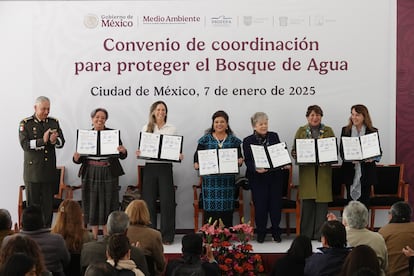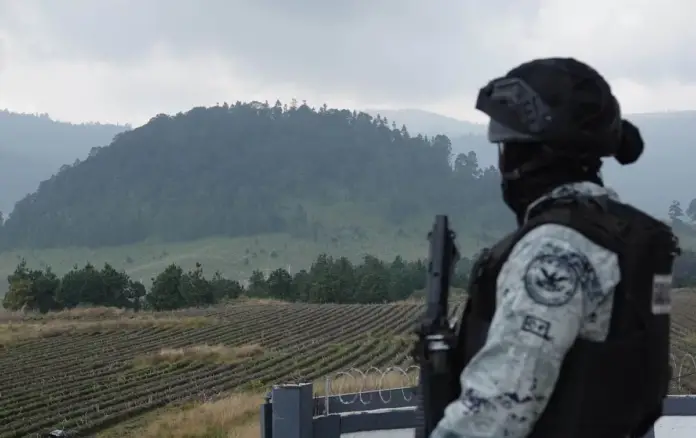
Mexico City, Morelos and the State of Mexico have launched this Tuesday to protect the Bosque de Agua, the forest corridor that crosses the three entities and is crucial in the water supply in the region. The three Executives, from the National Regeneration Movement (Morena), have presented a battery of measures with the support of the Government of Claudia Sheinbaum and in the midst of a water crisis that has affected the country for some years and increasingly strongly. The signed agreement intends to convert this region into a federal natural protected area, to be able to more easily combat the problems that plague the corridor, such as illegal logging, extraction of land from the mountain, change of land use and forest fires.
Since coming to power last October, Clara Brugada, the head of the capital’s government, has had her eye on the Bosque de Agua. The green corridor crosses not only the capital, but also the two neighboring states and three protected natural areas: the Ajusco-Chichinautzin biological corridor, the El Tepozteco national park and the Zempoala Lagoons. These almost 250,000 green hectares are home to 2% of the world’s biodiversity and 10% of the country’s biodiversity, and are the actor that supplies 70% of the water in Mexico City, and almost all of this resource in Cuernavaca, the capital of Morelos, and Toluca, the capital of the State of Mexico. “It has a strategic importance for the center of our country, it is the main source of water supply, not only for Mexico City, Cuernavaca and Toluca, but for the entire region,” said the federal attorney for Environmental Protection, Mariana Boy.
“This great city does not live off the contribution of Cutzamala or Lerma, it lives off the groundwater that infiltrates through the Bosque de Agua,” Brugada argued on Tuesday at the presentation of the agreement. The measures they have announced include operations to more frequently inspect the illegal extraction of forest resources, discourage logging and stop changes in land use, as well as providing resources to fight back, such as spaces to protect confiscated land, and criminally report the crimes they detect. Boy explained that in the past three months they have already begun surveillance operations, the installation of control filters, as well as patrols to control and inspections in sawmills to close down illegal ones.
Delfina Gómez, the governor of the State of Mexico, has explained that they are seeking to promote a decree to name the Bosque de Agua as a federal protected natural area. Currently the forest connects 21 protected natural areas, but the idea is to revoke those determinations to give one to the entire complex area as a whole. Before promoting it in Congress, where Morena has a majority, they will seek to have it approved in a popular consultation, a mechanism commonly used by former President Andrés Manuel López Obrador. Although they have not given dates for when the meeting would be, Brugada has added that they do not plan to take their finger off the line in this matter and that they will continue to meet periodically to address the plan.
“We have to guarantee that water sustainability continues through this great strategy,” the head of government has said. Margarita González, the governor of Morelos, has added that this corridor represents “one of the greatest riches” that there is in Mexico. “This water and environmental heart that guarantees the supply of drinking water for millions of people maintains a climatic balance in this region,” she said. “For Morelos this forest is fundamental, the water that supplies the valley of Cuernavaca, Cuautla and Yautepec comes from here.”
Alicia Bárcena, the Secretary of the Environment, was the one who called for the agreement to protect the area. “This is very important because we are going to lack water,” the official commented, “it is one of the resources that we are going to fight for in the future and therefore, before getting to that point, let us protect what we have.” Bárcena also said that they will hold a summit for the Water Forest on February 17, at the offices of the Mexican Institute of Water Technology in Cuernavaca.
The Water Forest is the source that feeds eleven aquifers essential for these three cities. But in this corner, which is fundamental for the water cycle, organized crime also operates freely. Some criminal groups have benefited from illegal logging for years and have become stronger as mafias with local roots. The three governments are facing a security problem, in addition to the water crisis, and that is why they called in the security forces on Tuesday. This illegal activity, together with the expansion of urban areas in the area, has caused a large reduction in the forest, which some specialists estimate to be between 30 and 40% of the total.
Source: elpais




